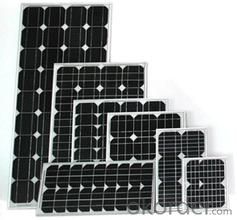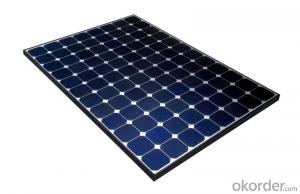Poly Solar Panel 100W A Grade with 12 Years Warranty
- Loading Port:
- Shanghai
- Payment Terms:
- TT OR LC
- Min Order Qty:
- 100 watt
- Supply Capability:
- 1000 watt/month
OKorder Service Pledge
OKorder Financial Service
You Might Also Like
Item specifice
Poly Solar Panel 100W A Grade with 12 Years Warranty
Production description
PV systems range from small, rooftop-mounted or building-integrated systems with capacities from a few to several tens of kilowatts, to large utility-scale power stations of hundreds of megawatts. Nowadays, most PV systems are grid-connected, while off-grid or stand-alone systems only account for a small portion of the market.The International Energy Agency projected in 2014 that under its "high renewables" scenario, by 2050, solar photovoltaics and concentrated solar power would contribute about 16 and 11 percent, respectively, of the worldwide electricity consumption, and solar would be the world's largest source of electricity. Most solar installations would be in China and India.[2]
It may also use a solar tracking system to improve the system's overall performance and include an integrated battery solution, as prices for storage devices are expected to decline. Strictly speaking, a solar arrayonly encompasses the ensemble of solar panels, the visible part of the PV system, and does not include all the other hardware, often summarized as balance of system (BOS). Moreover, PV systems convert light directly into electricity and shouldn't be confused with other technologies, such as concentrated solar power or solar thermal, used for heating and cooling.

Application
Commercial
Industrial
Residential
Product Feature
12 years quality warranty 25 years performance output.
Free for less than 5 pcs sample requirement
Free to replace or repair or refund if products fail to conform to the PI requirement.
Packaging
28pcs into carton 2carton into pallets 28pallets into a 40ft container
Delivery
After 25 days for manufacturered goods as soon as we received full payment.
After 10 days for stock goods as soon as we received full payment.
- Q:What is the usage of solar cells?
- Solar cells can be used in many different places, such as the power supply factories.
- Q:How long do solar cells last?
- Solar cells typically last for about 25 to 30 years. However, with proper maintenance and care, they can continue to function effectively for even longer periods of time.
- Q:Can solar cells be used in underwater vehicles?
- Yes, solar cells can be used in underwater vehicles. However, their efficiency may be reduced due to the limited availability of sunlight underwater.
- Q:Where can I get a competitive price for this solar cell? The 2bb/3bb polycrystalline solar cell panel?
- You can try this website, alibaba to find what you need, because I purchased the 2bb/3bb polycrystalline solar cell panel on that website last year.
- Q:What is the right way to operate a solar cell?
- To operate a solar cell system, the staff needs to have solid solar cell knowledge and operational experience.
- Q:How do solar cells perform in areas with frequent thunderstorms?
- Solar cells can still perform efficiently in areas with frequent thunderstorms, although their performance may be affected during periods of heavy cloud cover or rainfall. Thunderstorms can temporarily reduce sunlight exposure, leading to a decrease in solar cell output. However, solar cells are designed to withstand various weather conditions, and their performance can quickly recover once the storms pass. Additionally, advancements in solar technology, such as the use of anti-reflective coatings and improved cell designs, help to enhance performance even in less ideal weather conditions.
- Q:Can solar cells be used for powering hotels?
- Yes, solar cells can be used for powering hotels. Solar energy is a clean and renewable source of power that can be harnessed through the use of solar cells, also known as photovoltaic panels. These panels convert sunlight into electricity, which can be utilized to power various appliances and systems in hotels. By installing solar panels on rooftops or in open spaces, hotels can reduce their reliance on conventional energy sources, lower their carbon footprint, and potentially save on electricity costs in the long run.
- Q:Are solar cells affected by extreme temperatures?
- Yes, solar cells are indeed affected by extreme temperatures. High temperatures can cause solar cells to degrade and operate less efficiently, resulting in a decrease in power output. Similarly, extremely low temperatures can also reduce the performance of solar cells, although to a lesser extent. Therefore, it is important to consider temperature conditions when designing and installing solar panels to optimize their performance and longevity.
- Q:Can solar cells be used in military vehicles or equipment?
- Yes, solar cells can be used in military vehicles or equipment. They provide a sustainable and reliable source of energy, reducing dependency on traditional fuel supplies and enhancing operational efficiency. Solar-powered systems can be integrated into various military applications such as portable power units, communication systems, surveillance equipment, and even hybrid electric vehicles, making them more environmentally friendly and cost-effective in the long run.
- Q:The advantages and effects of solar energy
- Solar batteries are widely used, such as artificial satellites, unmanned weather stations, communication stations, TV relay stations, solar clocks, electric pole, black light, beacon lights, railway lights. Solar thermal conversion technology products, such as water heaters
1. Manufacturer Overview |
|
|---|---|
| Location | |
| Year Established | |
| Annual Output Value | |
| Main Markets | |
| Company Certifications | |
2. Manufacturer Certificates |
|
|---|---|
| a) Certification Name | |
| Range | |
| Reference | |
| Validity Period | |
3. Manufacturer Capability |
|
|---|---|
| a)Trade Capacity | |
| Nearest Port | |
| Export Percentage | |
| No.of Employees in Trade Department | |
| Language Spoken: | |
| b)Factory Information | |
| Factory Size: | |
| No. of Production Lines | |
| Contract Manufacturing | |
| Product Price Range | |
Send your message to us
Poly Solar Panel 100W A Grade with 12 Years Warranty
- Loading Port:
- Shanghai
- Payment Terms:
- TT OR LC
- Min Order Qty:
- 100 watt
- Supply Capability:
- 1000 watt/month
OKorder Service Pledge
OKorder Financial Service
Similar products
New products
Hot products
Related keywords


























